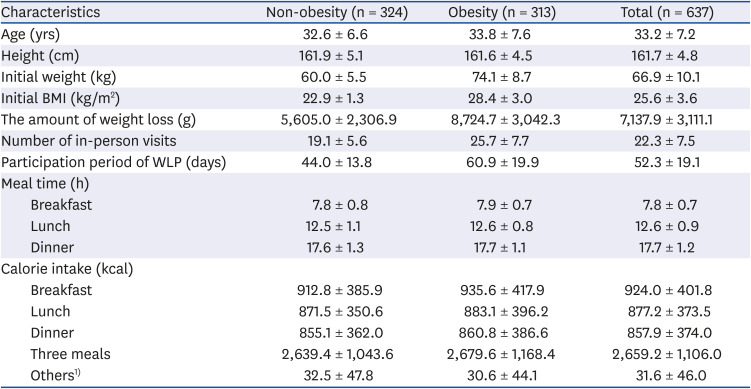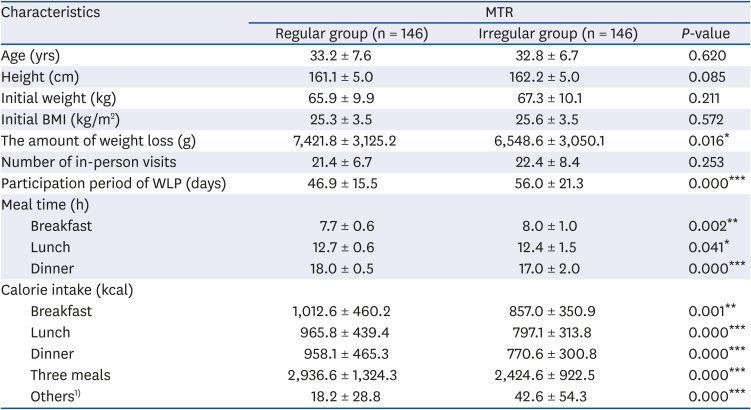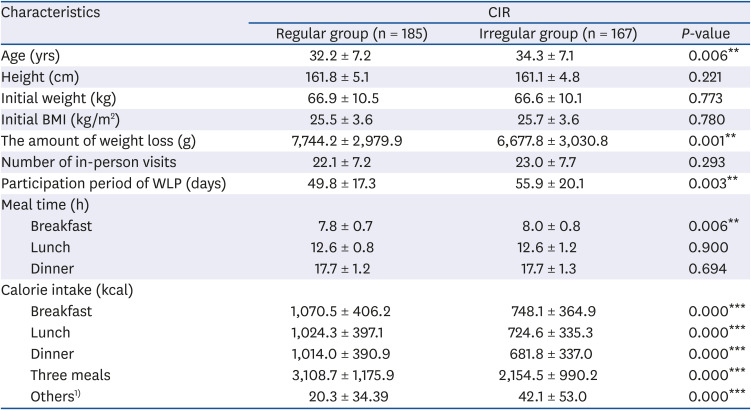1. Kruger J, Galuska DA, Serdula MK, Jones DA. Attempting to lose weight: specific practices among U.S. adults. Am J Prev Med. 2004; 26:402–406. PMID:
15165656.
2. Ogden CL, Carroll MD, Fryar CD, Flegal KM. NCHS Data Brief No. 219. Prevalence of obesity among adults and youth: United States, 2011–2014. Washington, D.C.: U.S. Department of Health and Human Services;2015.
3. Heshka S, Anderson JW, Atkinson RL, Greenway FL, Hill JO, Phinney SD, Kolotkin RL, Miller-Kovach K, Pi-Sunyer FX. Weight loss with self-help compared with a structured commercial program: a randomized trial. JAMA. 2003; 289:1792–1798. PMID:
12684357.
4. Gudzune KA, Doshi RS, Mehta AK, Chaudhry ZW, Jacobs DK, Vakil RM, Lee CJ, Bleich SN, Clark JM. Efficacy of commercial weight-loss programs: an updated systematic review. Ann Intern Med. 2015; 162:501–512. PMID:
25844997.
5. Larson NI, Nelson MC, Neumark-Sztainer D, Story M, Hannan PJ. Making time for meals: meal structure and associations with dietary intake in young adults. J Am Diet Assoc. 2009; 109:72–79. PMID:
19103325.
6. Sierra-Johnson J, Undén AL, Linestrand M, Rosell M, Sjogren P, Kolak M, De Faire U, Fisher RM, Hellénius ML. Eating meals irregularly: a novel environmental risk factor for the metabolic syndrome. Obesity (Silver Spring). 2008; 16:1302–1307. PMID:
18388902.
7. Sjöberg A, Hallberg L, Höglund D, Hulthén L. Meal pattern, food choice, nutrient intake and lifestyle factors in the Göteborg Adolescence Study. Eur J Clin Nutr. 2003; 57:1569–1578. PMID:
14647222.
8. Schlundt DG, Hill JO, Sbrocco T, Pope-Cordle J, Sharp T. The role of breakfast in the treatment of obesity: a randomized clinical trial. Am J Clin Nutr. 1992; 55:645–651. PMID:
1550038.
9. Yang RJ, Wang EK, Hsieh YS, Chen MY. Irregular breakfast eating and health status among adolescents in Taiwan. BMC Public Health. 2006; 6:295. PMID:
17150112.
10. Pot GK, Hardy R, Stephen AM. Irregular consumption of energy intake in meals is associated with a higher cardiometabolic risk in adults of a British birth cohort. Int J Obes. 2014; 38:1518–1524.
11. Garaulet M, Gómez-Abellán P. Timing of food intake and obesity: a novel association. Physiol Behav. 2014; 134:44–50. PMID:
24467926.
12. Lopez-Minguez J, Gómez-Abellán P, Garaulet M. Timing of breakfast, lunch, and dinner. Effects on obesity and metabolic risk. Nutrients. 2019; 11:2624.
13. Sherman H, Genzer Y, Cohen R, Chapnik N, Madar Z, Froy O. Timed high-fat diet resets circadian metabolism and prevents obesity. FASEB J. 2012; 26:3493–3502. PMID:
22593546.
14. Sherman H, Frumin I, Gutman R, Chapnik N, Lorentz A, Meylan J, le Coutre J, Froy O. Long-term restricted feeding alters circadian expression and reduces the level of inflammatory and disease markers. J Cell Mol Med. 2011; 15:2745–2759. PMID:
20731750.
15. Di Lorenzo L, De Pergola G, Zocchetti C, L'Abbate N, Basso A, Pannacciulli N, Cignarelli M, Giorgino R, Soleo L. Effect of shift work on body mass index: results of a study performed in 319 glucose-tolerant men working in a Southern Italian industry. Int J Obes Relat Metab Disord. 2003; 27:1353–1358. PMID:
14574346.
16. Karlsson B, Knutsson A, Lindahl B. Is there an association between shift work and having a metabolic syndrome? Results from a population based study of 27,485 people. Occup Environ Med. 2001; 58:747–752. PMID:
11600731.
17. Cho KO, Jeong SY. The effects of regular dietary habits on obesity indices and nutrition intakes in adult males. J Korean Diet Assoc. 2007; 13:114–122.
18. Stunkard AJ. Eating patterns and obesity. Psychiatr Q. 1959; 33:284–295. PMID:
13835451.
19. Jakubowicz D, Barnea M, Wainstein J, Froy O. High caloric intake at breakfast vs. dinner differentially influences weight loss of overweight and obese women. Obesity (Silver Spring). 2013; 21:2504–2512. PMID:
23512957.
20. Lowery SE, Kurpius SE, Befort C, Blanks EH, Sollenberger S, Nicpon MF, Huser L. Body image, self-esteem, and health-related behaviors among male and female first year college students. J Coll Student Dev. 2005; 46:612–623.
21. Bish CL, Blanck HM, Serdula MK, Marcus M, Kohl HW 3rd, Khan LK. Diet and physical activity behaviors among Americans trying to lose weight: 2000 Behavioral Risk Factor Surveillance System. Obes Res. 2005; 13:596–607. PMID:
15833946.
22. Tsai AG, Wadden TA. Systematic review: an evaluation of major commercial weight loss programs in the United States. Ann Intern Med. 2005; 142:56–66. PMID:
15630109.
23. Kim GR, Kim MJ. A survey on the dietary behavior of high school students-about regularity of meal and number of meal per day. J Korean Soc Food Sci Nutr. 2011; 40:183–195.
24. The Korean Nutrition Society. Database of Food and Beverage Nutrients. Seoul: The Korean Nutrition Society;2015.
25. French SA, Jeffery RW. Consequences of dieting to lose weight: effects on physical and mental health. Health Psychol. 1994; 13:195–212. PMID:
8055855.
26. Sivak M. Sleeping more as a way to lose weight. Obes Rev. 2006; 7:295–296. PMID:
16866976.
27. Berkey CS, Rockett HR, Gillman MW, Field AE, Colditz GA. Longitudinal study of skipping breakfast and weight change in adolescents. Int J Obes Relat Metab Disord. 2003; 27:1258–1266. PMID:
14513075.
28. Croezen S, Visscher TL, Ter Bogt NC, Veling ML, Haveman-Nies A. Skipping breakfast, alcohol consumption and physical inactivity as risk factors for overweight and obesity in adolescents: results of the E-MOVO project. Eur J Clin Nutr. 2009; 63:405–412. PMID:
18043703.
29. Smith KJ, Gall SL, McNaughton SA, Blizzard L, Dwyer T, Venn AJ. Skipping breakfast: longitudinal associations with cardiometabolic risk factors in the Childhood Determinants of Adult Health Study. Am J Clin Nutr. 2010; 92:1316–1325. PMID:
20926520.
30. Deshmukh-Taskar PR, Nicklas TA, O'Neil CE, Keast DR, Radcliffe JD, Cho S. The relationship of breakfast skipping and type of breakfast consumption with nutrient intake and weight status in children and adolescents: the National Health and Nutrition Examination Survey 1999–2006. J Am Diet Assoc. 2010; 110:869–878. PMID:
20497776.
31. Sakata K, Matumura Y, Yoshimura N, Tamaki J, Hashimoto T, Oguri S, Okayama A, Yanagawa H. Relationship between skipping breakfast and cardiovascular disease risk factors in the national nutrition survey data. Nippon Koshu Eisei Zasshi. 2001; 48:837–841. PMID:
11725527.
32. Jakubowicz D, Wainstein J, Landau Z, Raz I, Ahren B, Chapnik N, Ganz T, Menaged M, Barnea M, Bar-Dayan Y, et al. Influences of breakfast on clock gene expression and postprandial glycemia in healthy individuals and individuals with diabetes: a randomized clinical trial. Diabetes Care. 2017; 40:1573–1579. PMID:
28830875.
33. Arble DM, Bass J, Laposky AD, Vitaterna MH, Turek FW. Circadian timing of food intake contributes to weight gain. Obesity (Silver Spring). 2009; 17:2100–2102. PMID:
19730426.
34. Bo S, De Carli L, Venco E, Fanzola I, Maiandi M, De Michieli F, Durazzo M, Beccuti G, Cavallo-Perin P, Ghigo E, et al. Impact of snacking pattern on overweight and obesity risk in a cohort of 11- to 13-year-old adolescents. J Pediatr Gastroenterol Nutr. 2014; 59:465–471. PMID:
24897170.
35. Rennie KL, Johnson L, Jebb SA. Behavioural determinants of obesity. Best Pract Res Clin Endocrinol Metab. 2005; 19:343–358. PMID:
16150379.









 PDF
PDF Citation
Citation Print
Print










 XML Download
XML Download